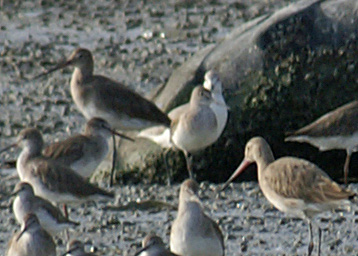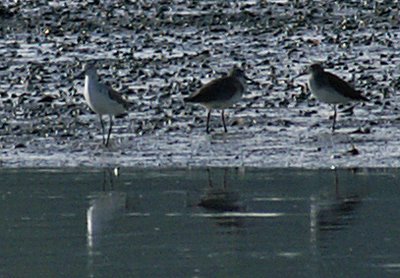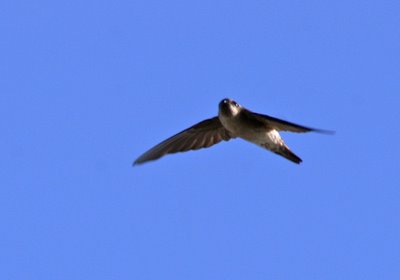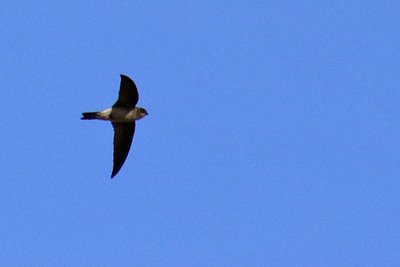After a break of over 3 weeks, I was somewhat afraid of what I might find, and prepared for the worst. Would there be houses all over the roost site? Would the 'Coffin' (my hide) still be there?
To my surprise - the Coffin was still there - more or less intact minus the roof, and the pool was still there too. Only problem was - no birds! A scan of the mudflats revealed precisely no sandplovers and no stints, and only a rather small flock of Whimbrel!
On closer inspection, it didn't look like the pool had been used as a roost for a while - no tell-tale feathers or droppings.
After a walk to the far end of the mudflats I did find a small roost of birds, but nothing like the thousands that were present 3 weeks ago. I counted;
Redshank 370
Greenshank 30
Marsh Sand 7
Curlew Sand 20
Pacific Golden Plover 6
Little Ringed Plover 5
Black-tailed Godwit 6
Whimbrel 20
The Black-tailed Godwits were my first of the autumn, so it was good to see them. Last time I saw Black-tails here there was a flock of Asian Dowitchers with them, so I scanned a second time just to make sure. The second time I scanned the flock out popped - not a dowitcher - but a lone Nordmann's Greenshank, my first for the island!

Not great photos, but a great bird! A Nordmann's Greenshank does its best to hide behind a Black-tailed Godwit.

On this picture you can just about make out the broad bill-base, rather like a Terek Sandpiper, and a good distinguishing feature of Normann's. Nordmann's in non-breeding plumage are ghostly pale, and usually stand out rather obviously as a consequence.

An even worse picture! This bird associated with the Redshanks, despite there being a flock of Greenshank present. It always kept to the edge of the flock, and seemed more wary than the birds around it.
I reflected sadly that this bird has probably never been in a flock of its own species the size of the Redshank flock it was with. The estimated world population of this species stands at just 500-1,000 birds, and it is threatened on both breeding grounds and at key migration sites. One of the most important staging sites for Nordmann's Greenshank, the Saemangeum estuary in South Korea, has recently been reclaimed, so the future for this fabulous species is depressingly bleak. For more information and some much better pictures, see here.
So what has happened to all the birds at Tanjung Tokong? Have they skipped over the strait to Bagan Tambang or Juru? Or maybe they have all headed further south? Time and further visits will tell.
As there was no prospect of photographing shorebirds today, I turned my attention to the swiftlets overhead. I've read recently that Himalayan Swiftlet is supposedly the commonest swiftlet species in southern Thailand during the non-breeding season, and it is regularly recorded in Singapore. Despite this, there are no accepted records for Penang. There is also some confusion over what resident species occur here. Traditionally Black-nest and Edible-nest Swiftlet are named as resident, but Robson's Birds of South-east Asia notes Edible-nest as a vagrant to South-east Asia, while Germain's Swiftlet is recorded as a common resident of Peninsular Malaysia.
The resident swiftlets are thought to be only reliably identifiable in the hand or at the nest (the composition of the nest is diagnostic), but Himalayan is reckoned to be distinguishable in the field by the more notched tail and possibly longer wings. But I confess I am a complete novice in this area, so I offer the photos for comment by the better informed!

Plumage-wise, these birds have very pale underparts and rumps, contrasting with darker brown underwing and upperparts. There are fairly obvious darker feather centres on the ventral area.

A view of the upperside, showing the pale rump. No tail notch is visible when the tail is held closed. Several birds were in primary and secondary moult, like this one.

Some birds had very full crops, as if they were collecting insects to feed young in the nest. If this was the case, they must be one of the resident species. A reasonable tail notch is visible here.

Here's a fairly good view of the typical flight shape - quite long-winged and with a good tail notch. Also a noticeably paler throat patch.

Another view of the topside. This bird shows a pale collar as well as rump patch.
Of course, there could have been more than one species involved here but I'd rather not even contemplate that thought! I'd be very interested to hear your opinions on the identity of any of these birds.
No comments:
Post a Comment